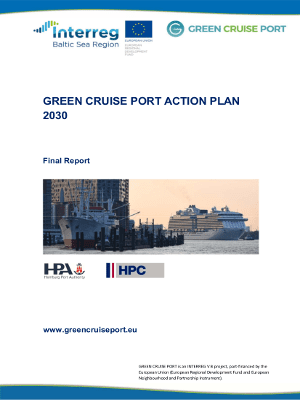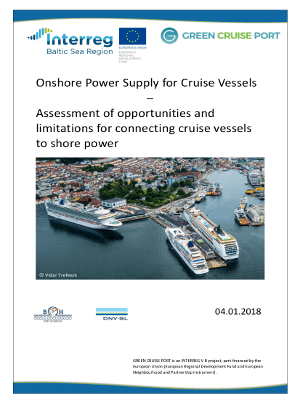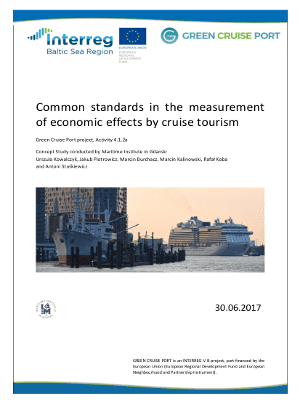GREEN CRUISE PORT
The cruise shipping sector in the Baltic Sea region has grown enormously in the last decade. From 2001 to 2013 cruise ship calls (visits by a cruise ship at a port) grew by a total of 59 % (1,601 to 2,552), and passenger visits increased by over 260 % (1.2 million to 4.4 million). Cruise tourism is expected to continue growing in the Baltic Sea region. Meeting the fast growing demand and the associated environmental requirements in the cruise sector in a strategic, sustainable manner is necessary. Because the “cruise product” is transnational by its nature, only a joint planning process of ports in the region will have lasting results.
Budgets
in numbers
-
2.76MillionTotal
-
1.93MillionErdf
-
0.00MillionEni + Russia
-
0.15MillionNorway
Achievements
Eight ports and two cruise lines explore green solutions together
In the project, the port authorities of eight large cruise ports in the Baltic Sea region joined forces, namely Hamburg (Germany), Rostock (Germany), Klaipeda (Lithuania), Riga (Latvia), Tallinn (Estonia), Helsinki (Finland), Bergen (Norway) and Esbjerg (Denmark) for an ambitious approach towards green cruise ports. The port authority RosMorPort which operates the ports of St. Petersburg and Kaliningrad (Russia) contributed as well. Together with the cruise lines AIDA and TUI as well as researchers from the Maritime Institute in Gdansk they looked into smart solutions for greener cruise ports in terms of sustainable energy supply and innovative emission reduction, cruise terminal buildings and innovative reception facilities and maritime and landside cruise terminal traffic links and published a series of thematic studies in each of those fields. A study on "Sustainable energetic solutions for the cruise terminal building in Northern climate" laid the fundament for an engineer-layout of a smart cruise terminal building at the Port of Tallinn. The new terminal was built 2019.
A common vision and an action plan for green cruise tourism by 2030
To bring all the experience and ambitions together, the ports established a joint vision: To decouple growth in the Baltic Sea region cruise port industry from negative sustainability, and especially environmental impacts that result from port and vessel operations. In order to pursue this vision, the ports and cruise lines developed a Green Cruise Port Action Plan 2030 with specific goals for its realization. The Action Plan serves as an important tool and source of reference for ports, cruise lines, policy and others striving for a high level of sustainability. In 2017, the Baltic Sea Forum awarded the project the Baltic Sea Clean Maritime Award in the category “Infrastructure”. EUR 1.93 million of support from the European Union were used to initiate change in the cruise industry towards a green, low-carbon Europe in the Interreg project Green Cruise Ports.
Outputs
Green Cruise Port Action Plan 2030

Report: Onshore power supply for cruise vessels

Study: Common standards in the measurement of economic effects by cruise tourism

Technical study: Sustainable energetic solutions for the cruise terminal building in Northern climate

Project Stories
-
01.04.2019
Greener cruising across the Baltic Sea
Cruise shipping in the Baltic Sea region has grown enormously. In 2018, the number of cruise guests visiting destinations at the Baltic Sea was almost five times higher than in 2000 and the boom is expected to last at least. More passengers means more jobs and growth for the port locations and their hinterland.Read full story
Partners
Hamburg Port Authority
- TownHamburg
- RegionHamburg
- CountryGermany
- RepresentativeIngo Fehrs
- Phone
- E-Mail
- Web
Hamburg Cruise Net
- TownHamburg
- RegionHamburg
- CountryGermany
- RepresentativeEllen Rüdiger
- Phone
- E-Mail
- Web
ROSTOCK PORT
- TownRostock
- RegionRostock, Kreisfreie Stadt
- CountryGermany
- RepresentativeMario Lembke
- Phone
- E-Mail
- Web
Freeport of Riga Authority
- TownRiga
- RegionRīga
- CountryLatvia
- RepresentativeEdgars Sūna
- Phone
- E-Mail
- Web
Port of Tallinn
- TownTallinn
- RegionPõhja-Eesti
- CountryEstonia
- RepresentativeMarju Zirel
- Phone
- E-Mail
- Web
SE Klaipeda State Seaport Authority
- TownKlaipeda
- RegionKlaipėdos apskritis
- CountryLithuania
- RepresentativeŽymantas Sinkevičius
- Phone
- E-Mail
- Web
Port of Helsinki LTD
- TownHelsinki
- RegionHelsinki-Uusimaa
- CountryFinland
- RepresentativeKari Noroviita
- Phone
- E-Mail
- Web
Maritime Institute in Gdansk
- TownGdansk
- RegionGdański
- CountryPoland
- RepresentativeMarcin Kalinowski
- Phone
- E-Mail
- Web
Port of Bergen
- TownBergen
- RegionHordaland
- CountryNorway
- RepresentativeEven Husby
- Phone
- E-Mail
- Web
Port of Esbjerg
- TownEsbjerg
- RegionSydjylland
- CountryDenmark
- RepresentativeJesper Bank
- Phone
- E-Mail
- Web
-
Project managerManfred LebmeierHamburg Port Authority
-
Legal representativeIngo FehrsHamburg Port Authority
-
Financial managerIngo FehrsHamburg Port Authority
-
Communication managerIngo FehrsHamburg Port Authority



